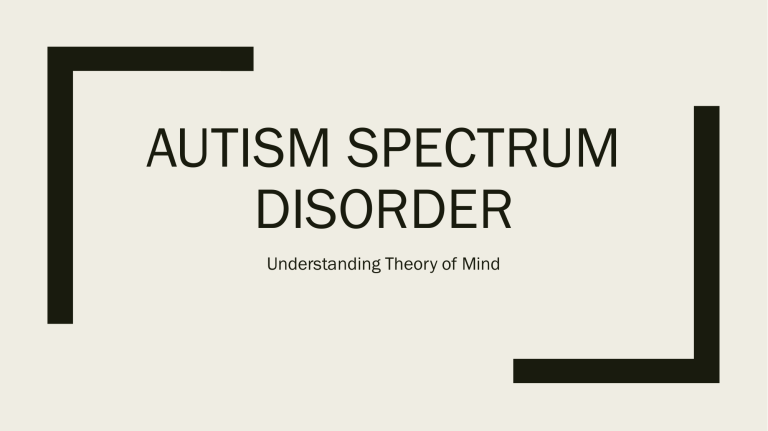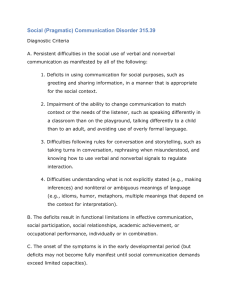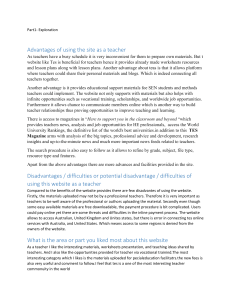
AUTISM SPECTRUM DISORDER Understanding Theory of Mind Autism Spectrum Disorder (ASD) ■ Developmental disabilities that can cause significant challenges in areas – social – communication – behavioral ■ Wide range of symptoms and severity spectrum – different and unique per case ■ Prevalence: 1/54 ■ Signs usually appear by age 2 or 3 Diagnostic Criteria A. Persistent deficits in social communication and social interaction across multiple contexts, as manifested by the following, currently or by history: 1. Deficits in socio-emotional reciprocity ranging from abnormal social approach and failure of normal back-and- forth conversation; to reduced sharing of interests, emotions, or affect; to failure to initiate or respond to social interactions . 2. Deficits in nonverbal communicative behaviors used for social interaction ranging from poorly integrated verbal and nonverbal communication; to abnormalities in eye contact and body language or deficits in understanding and use of gestures; to a total lack of facial expressions and nonverbal communication. 3. Deficits in developing, maintaining, and understanding relationships ranging from difficulties adjusting behavior to suit various social contexts ; to difficulties in sharing imaginative play or in making friends; to absence of interest in peers. Diagnostic Criteria B. Restricted, repetitive patterns of behavior, interests, o activities, as manifested by at least two of the following currently or by history: Stereotyped or repetitive motor movements, use of objects, or speech (e.g., simple motor stereotypies, lining up toys or flipping objects, echolalia, idiosyncratic phrases). 1. Insistence on sameness, inflexible adherence to routines , or ritualized patterns or verbal nonverbal behavior (e.g. extreme distress at small changes, difficulties with transitions rigid thinking patterns, greeting rituals, need to take same rout or eat food every day). 2. Highly restricted, fixated interests that are abnormal intensity or focus (e.g., strong attachment to or preoccupation with unusual objects, excessively circumscribed or perseverative interest). 3. Hyper- or hyperreactivity to sensory input or unusual interest in sensor y aspects of the environment (e.g. , apparent indifference to pain /temperature , adverse response to specific sounds or textures, excessive smelling or touching of objects visual fascination with lights or movement). Diagnostic Criteria C. Symptoms must be present in the early developmental period (but may not become fully manifest until social demands exceed limited capacities or may be masked by learned strategies in later life). D. Symptoms cause clinically significant impairment in social, occupational, or other important areas of current functioning. E. These disturbances are not better explained by intellectual disability (intellectual developmental disorder) or global developmental delay. Intellectual disability and autism spectrum disorder frequently co-occur; to make comorbid diagnoses of autism spectrum disorder and intellectual disability, social communication should be below that expected for general developmental level. Specify: With or without accompanying intellectual impairment With or without accompanying language impairment Associated with a known medical or genetic condition or environmental factor Associated with another neurodevelopmental, mental, or behavioral disorder Severity Levels Essential Symptoms ■ Deficits in social communication and social interaction – interpersonal relationships – social reciprocity – poor eye contact ■ Restricted, repetitive behaviors, interests of activities – self-stimulatory behavior – excessive attachment to routines – resistant to transitioned – special interests Other Possible Impairments ■ Sensory – over-sensitivity/hypersensitivity Activity Look at the picture and share with someone next to you where Sally look for her marble? And why? Theory of Mind (ToM) ■ Understand that others have beliefs, desires and intentions that can be different from our own – Taking perspective – Empathy – Imitating What you might see in your students ■ Students may lack – joint attention – picking up social cues – understanding other’s desires Why students with ASD lack ToM ■ People with an ASD diagnosis use language for a “limited range of communicative functions, ■ and rarely for social functions (e.g., Chin& Bernard-Opitz, 2000) ■ nA meta-analysis of ToM tasks found that children with ASD required a much higher verbal ability to pass ToM tasks than typically developing children or children with Intellectual Development Disorders (Happe, 1995) ■ n...However, children with ASD are still delayed on non-verbal ToM tasks (Colle et al., 2007) What can we do? ■ Direct instruction of social skills – socio-emotional learning – social stories ■ Reinforcement systems for prosocial behaviors ■ Fluency of transitions ■ Mediate social interactions – play time – structured group activity Using Social Stories Use visuals and story formals to teach students routines, expectations, and prosocial behaviors Reinforcing Prosocial Behaviors ■ Find what the student finds reinforcing ■ Explain the exact behavior they are being reinforced for Transition Fluency ■ Review today’s schedule and expectations ■ Discuss all possible transitions Mediate Social Interactions ■ Play time ■ Group work ■ Conversations Questions?


